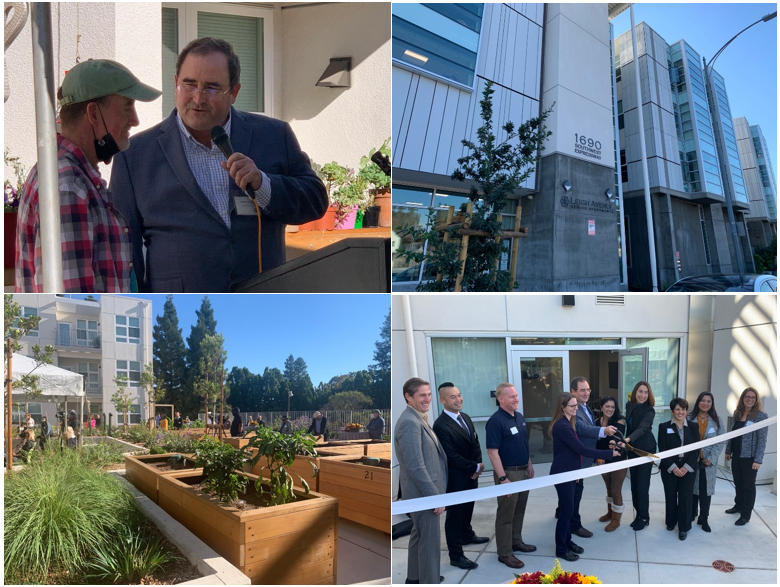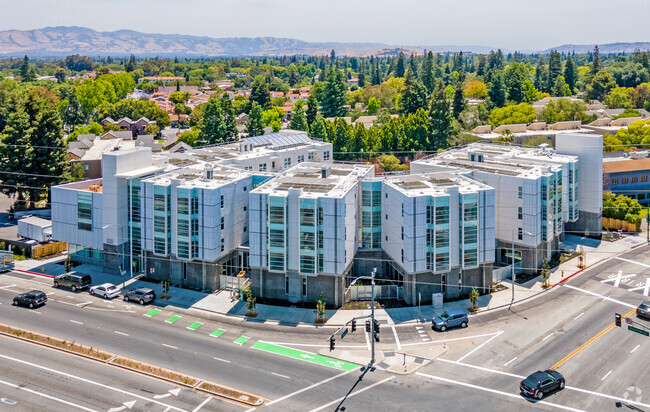Welcome to SV@Home’s Policy Rundown, your need-to-know overview of important housing policy actions and developments from the past two weeks.

Santa Clara Homekey Proposals: Bella Vista Advances; White Oak Halted
Last Tuesday, the Santa Clara City Council held a study session to consider two proposed Homekey projects: the Bella Vista Inn on El Camino Real (with the potential for 120 new homes) and LifeMoves interim housing on White Oak Lane (with the potential for 60 new homes).
The Bella Vista Inn property is owned and co-sponsored by the County of Santa Clara, who selected Resources for Community Development (RCD) to develop the project. As it is a County project and advancing under the County’s and RCD’s leadership, further city study was not required. However, the LifeMoves interim housing project did require the city as a co-sponsor and was largely the focus of the meeting.
Armed with misinformation and fear, a strong, organized opposition to the project pressed the Council to reject efforts to provide much-needed housing for people experiencing homelessness. Ultimately, Council denied the White Oak Lane project from advancing, citing traffic concerns. SV@Home is deeply disappointed by this decision, since the property is actually a perfect location for much-needed housing, surrounded by residential uses on all sides except Lawrence Expressway.
Although Council instructed staff to find “a more appropriate” location for the LifeMoves project, denying the White Oaks interim housing project is a lost opportunity for the city to take a lead in furthering its goal of addressing homelessness throughout the community.
A coalition of housing groups including Destination:Home, CatalyzeSV, and SV@Home encourage housing advocates to turn-out in support of these noteworthy Homekey projects; despite Tuesday’s setback, now is a great time to reinforce those messages and let our elected leaders know that Homekey projects are needed community assets that benefit us all.
Santa Clara Board of Supervisors Approves Funding Improvements to Enable More IDD Housing
Earlier this week, the Board of Supervisors approved staff recommendations to make improvements to the Measure A Affordable Housing Bond Guidelines, which included adjustments to make it easier for developers to create homes for people with Intellectual and Developmental Disabilities (IDD).
SV@Home strongly supported the increased flexibility for developers, which fixed previous requirements at a minimum of 25% of all units in a project be reserved for people with IDD, which made the inclusion of these units in large projects financially difficult. The updated requirements now call for a minimum of 10 homes and caps the maximum required at 25% of homes in a project, making it feasible for larger housing developments (for example, those being built near transit hubs) to accommodate the inclusion of IDD homes. These updates are another example of actions the Board has taken to make it possible for all residents, including those with IDD, to continue to call Santa Clara County home.

First Community Housing Opens Leigh Ave Senior Apartments
Today, First Community Housing officially opened its 64-unit Leigh Ave Senior Apartment project to the community. The project is beautiful, quiet, safe, and adjacent to transit. Elected officials, nonprofit partners, advocates, and residents gathered to celebrate on the terrace garden. Geoff Morgan, CEO of First Community Housing invited three residents to share their lived experience and what the project meant to them. Each had a unique story, but all shared a deep appreciation for the project and the opportunity to be housed. It was an exciting and joyous occasion!
Palo Alto Update: Tenant Protections at City Council, still no vote!
On Monday, the Palo Alto City Council once again ran out of time to fully consider and vote on the package of renter protections up for consideration. The good news is a number of the recommendations, including reactivating the city’s existing rent registry, appeared to have solid support. The item was continued again, this time tentatively to November 29th.
Last month the council heard extensive public testimony on multiple sides of the issue. The number of sincere, if painful, personal stories and perspectives was moving. Thank you to the many of you who showed up (logged on) to show support for renter protections in Palo Alto!
We’ve culled through the transcript for comments that captured the evening:
“I came to Palo Alto as a kid in the 80s because as my dad put it, we won the golden ticket: A below market rate home that took our section eight voucher in Palo Alto. While I felt and have appreciated the many ways that I’ve benefited from the access and the proximity of the resources here in Palo Alto, being a low income family striving to make ends meet had its downfalls. Being a renter in a family that rented, we never felt protected. We lacked a basic sense of security, where we called our home a place we really could feel secure.” -Leah C.
“I’ve lived in Palo Alto as a renter with my husband for about 40 years… here in Palo Alto. We’re lucky that we have a good landlady who has been kind to us by not raising our rent a lot in the past few years… But she has also indicated that she wants to sell the apartment building… I think we’re protected by AB 1482… so that’s good for us, but if our building gets sold, what happens to us? I’m worried. I’m worried about having to leave.” -Julie B.
“I recognize that the reason I’m a homeowner, though I prefer renting, is mostly to avoid getting displaced. As our kids approached school going age, we wanted to make sure we never had to move schools because the landlord decided to go in a different direction. I once was forced to move because my then landlord was confused about his taxes. He’s a great guy, but a little bit of a doofus in that way. In my situation, that was just a hassle and a little bit funny in retrospect, but as many have recounted, the humanitarian consequences of being forced out of a rental can be extremely dire during a housing crisis. And ownership is out of reach for too many people for ownership to be the only road to housing stability.” -Scott O.
Public comment has been closed on the item, but you can still send emails of support to City.Council@cityofpaloalto.org. You can view SV@Home’s talking points here.
Mountain View City Council Holds Study Session on the Housing Element Update
On Tuesday evening, the Mountain View City Council held a study session to get an update on the progress of the Housing Element Update. Housing Element Updates are the planning documents that every jurisdiction in the State is required to complete and submit to the California Department of Housing and Community Development (HCD). The Housing Elements must include land use maps that identify places that housing can be built over the next eight years to accommodate the Regional Housing Need Allocation (RHNA) for the jurisdiction, as well as policies and programs that are currently in place, or will be added, to respond to the diversity of housing needs. This RHNA cycle (Cycle 6, 2023 – 2030) the required number of new homes that cities/towns must plan for has increased significantly. Mountain View is required to plan for 11,135 new homes, 6,255 below market rate. All 16 of the jurisdictions in Santa Clara County must submit their Housing Element updates to the state by January 1, 2022.
There were a couple of key takeaways, some of which are common across jurisdictions in the County, and others that were very specific to Mountain View. First, Mountain View, like most jurisdictions, is falling far short of meeting the affordable housing production RHNA requirements for the current period (Cycle 5, 2015-2022). While it has built 4,607 new market rate homes (422% of the RHNA target), it has built only 244 new homes affordable to very low-income households (30% of the RHNA target). Unfortunately, Mountain View has also seen a significant number of more affordable homes in the private market demolished and rebuilt as higher costs housing, which is not yet common in other jurisdictions. During the study session, one councilmember asked if it was possible that over the last six years the city had actually seen a net reduction in affordable homes, staff acknowledged that this was possible.
Another shared challenge across jurisdictions is that despite specific planning efforts to redevelop new areas, or update general plans, most of these new plan areas are projected to be built out over decades, and so only a portion of the planned housing can be reasonably expected to be developed in the next eight years. Mountain View has undertaken some major planning efforts (including North Bayshore and East Whisman) in recent years, but not all of the new homes can reasonably be expected to come from these areas, and the state law on Affirmatively Furthering Fair Housing requires that affordable homes be planned throughout the city. As a result, staff expects that roughly a third of the homes they will need to plan for, especially the affordable homes will need to be identified outside existing plan areas. In Mountain View, these newly planned areas face an additional hurdle as a proposed increase in school taxes threatens the feasibility of housing construction of any kind in the northern section of the city.
The final key takeaway from the evening is also common across jurisdictions, but particularly troubling for Mountain View. For some time the city has been doing the policy work to integrate modest increases in allowable density with more robust tenant protections in areas of the city with a mix of multifamily and single family homes. It was in these areas where older apartments with lower rents were demolished and replaced by new townhouses with very high purchase prices. Although the Council has been supportive of this effort, the planning department took the item, known as the “R3 Zoning Update,” off the table for integration into the housing element process. It was clear from various public comments that single family residents of R3-zoned neighborhoods were opposed to changes. Most agreed the changes should happen someplace else. The R3 Zoning Update process will move forward, but without the broader context of a citywide discussion about how to plan for a future that will require more housing in more places, it feels far less certain that this will result in real progress than it did before staff took that step back.

